If you want to skip directly to the other parts, then just hit
Part II - Ambon/Sulawesi or
Part III - Kalimantan or
Part IV - Sumatra.
Introduction
This is an abridged description of a roundtrip through Indonesia commencing October 1987. The intention is to give a firsthand personal experience of how I did get to and through the country or from island to island. Despite the fact that I did not book anything in advance at all (except for the flight to Jakarta) and that I covered more than 10,000 km within the country during the 40 days, it was no problem getting any means of transport (even domestic flights) or accommodation on the same day. I only did some kind of pre-planning in so far that I wanted to be back in Jakarta at least a day before my scheduled return flight to Germany.
At the time of writing all this, more than 20 years have passed. What I had seen and experienced, may not be the way today anymore. Cultures and customs change rapidly in our global world, not necessarily to the better, especially for all the indigenous people I met.
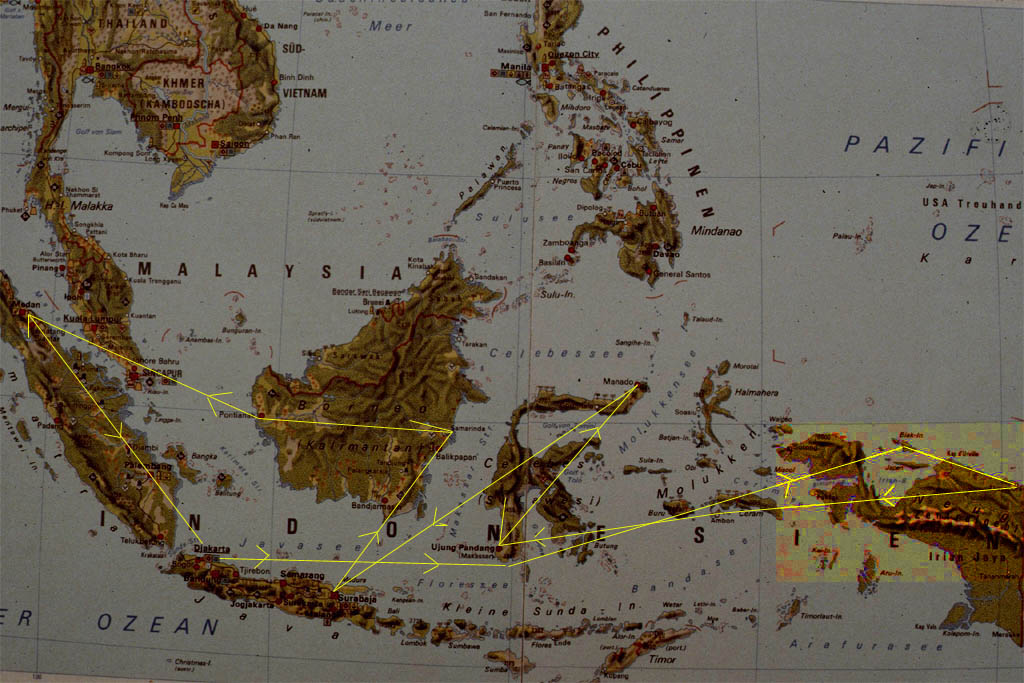
Getting from Germany to Papua
The return flight from Frankfurt to Jakarta with Garuda (the national carrier of Indonesia) did cost 1,800 DM (almost 900 Euro). The air-pass within all of Indonesia and valid for 2 months was another 800 DM (almost 400 Euro). The air-pass was not like a pass to hop on and off any airplane as you wish, but for each planned leg a separate ticket had to be issued in advance. So I sat down at the travel agency and studied the ABC guide of all flights worldwide and came up with my own itinerary comprised of 16 legs, (some tentative), thus 16 additional tickets, of which I actually only used 10 (see map above). A lot of work for the travel agent to fill them all out the old fashioned way.
In order to get from Cologne to Frankfurt I had to take the train. Arrival time in Jakarta was early afternoon. My connection flight to Jayapura (Papua) via Ujung Pandang (now Makassar again) and a stopover in Biak was early next morning at 5 a.m. Since there was no way to stay and sleep in the airport terminal, I booked a room in the Cengkareng Transit Hotel for 18 USD (including shuttle service) with the help of the friendly guys of the Tourist Welcome Center at the airport (for staying in Jakarta see "Arriving in Jakarta" in part IV).
Remark: The photos on the right side may not be correctly adjusted if you use Mozilla Firefox or Chrome. I propose to use the Explorer of Microsoft instead.
Click the small picture to get it enlarged
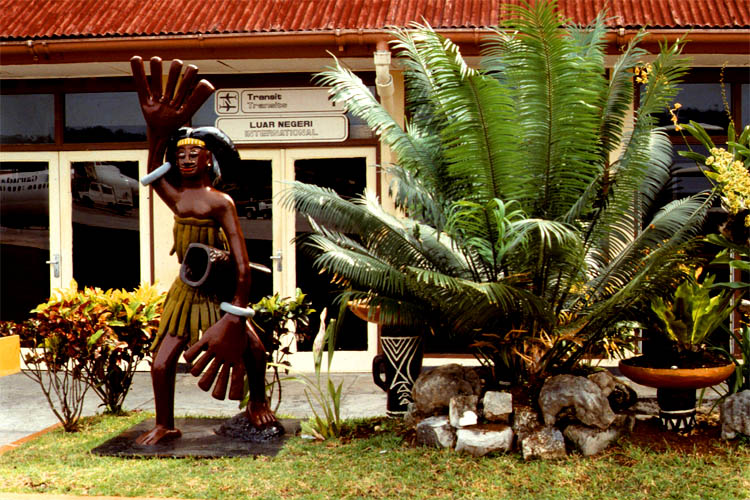
| Biak
|

| Islands
|
Jayapura
Late afternoon I arrived in Jayapura, the provincial capital of Papua. The old name of Papua was Irian Jaya at the time I was there. The airport is in Santani, around 35km from Jayapura. I was lucky to get a lift together with another passenger who was picked up by relatives. But no invitation in their house, though, so I had to find my own accommodation, which was the
Hotel Dafonsoro
Jalan Percetakan No. 20-24
Jayapura
|
for around 22 USD (including 20% service charge and tax). Pretty expensive but the best place in town (my airline crew also stayed here), and there were not many to choose from.
Next morning I obtained the permit (submitting four photographs) from the police station to visit the Danis in the Baliem Valley and then I booked the early morning flight to Wamena for the next day (36 USD roundtrip with Merpati).

| Jayapura
|

| WW II remnants
|
Now I had some time to explore the vicinity (not much to see in Jayapura itself). Papua was occupied by the Japanese during WW II and the Americans landed here in the year 1944. You can still see the old rusting landing boats on the beach. A monument commemorates that historic event, obligatory visiting site for school children.
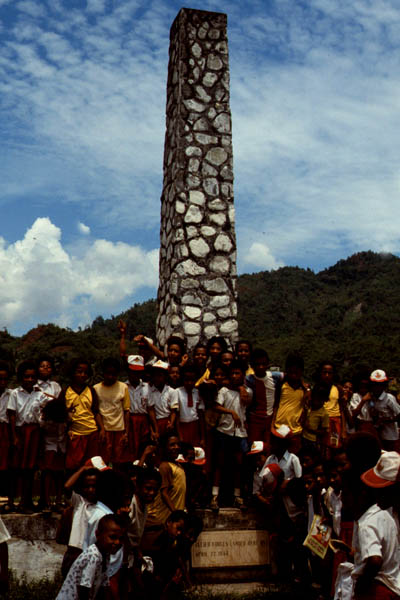
| Victory column with school children
|

| These young boys don't know war
|
Then I took a colt (minibus) for 1 USD (a taxi would have cost 15 USD) to Santani, where I stayed the second night for 11 USD at the
Losmen Minang Jaya
Jalan Bestur
Sentana
|
which was conveniently located just 200 meters from the airport, but it was infested with rats, which had a feast during the night with my provision I had bought in Jayapura.
First day in the Baliem Valley
Starting in the morning at 7 a.m. we flew for one hour above a vast virgin forest until we landed in Wamena, the only town in the Baliem Valley. Yes, I was not alone anymore: a girl from Chicago asked whether she may join me and sat just right next to me on that almost empty plane. Her name was Kate (divorced from a guy who turned gay).
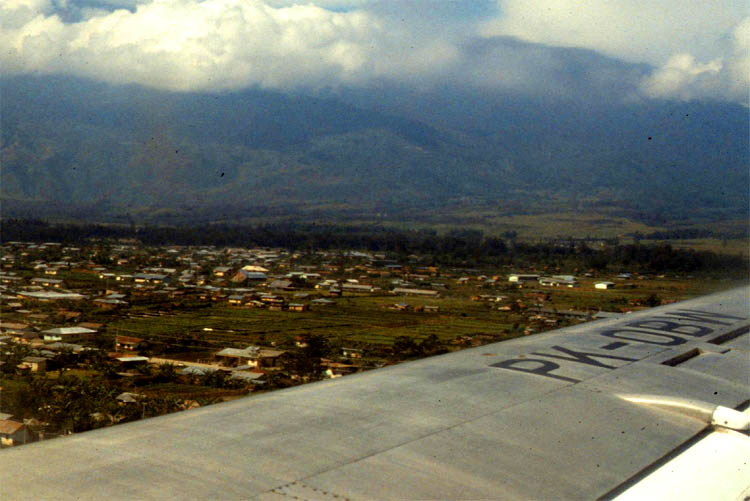
| Landing in Wamena
|
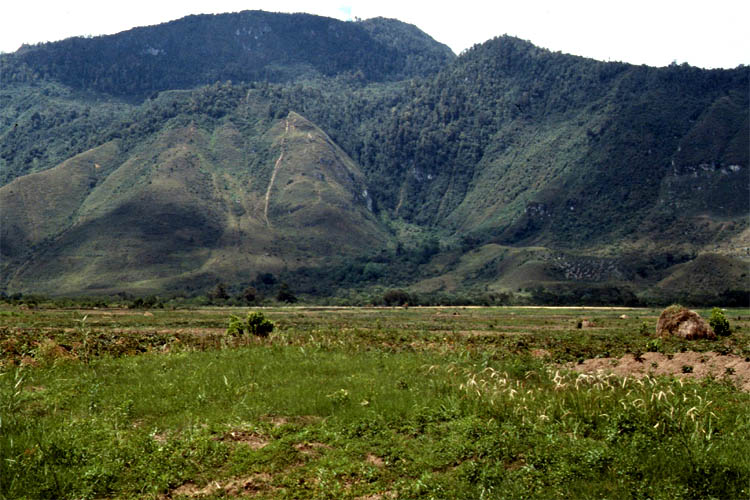
| in the Baliem Valley
|
But unfortunately she could not present the permit (she didn't know that she needed one) to the Staff Security Officer, Justinus Daby, who was a very friendly Papua of the Dani tribe. He spoke an excellent American English taught by an American missionary. Instead of being interned he asked his boss whether he may take care of her until she can fly back with the next plane next day.
Taking care of her also meant taking care of me: he invited us to his home village where a pig slaughter festival was just taking place ... and also offered us a place to stay overnight in one of his native huts in a small village compound, where we went first to leave our luggage but after we had bought some packages of cigarettes in town as a present for the chief, as our officer suggested. Then we all went off (his brother joined us) on hidden small tracks while jumping over creeks to an unknown adventure.
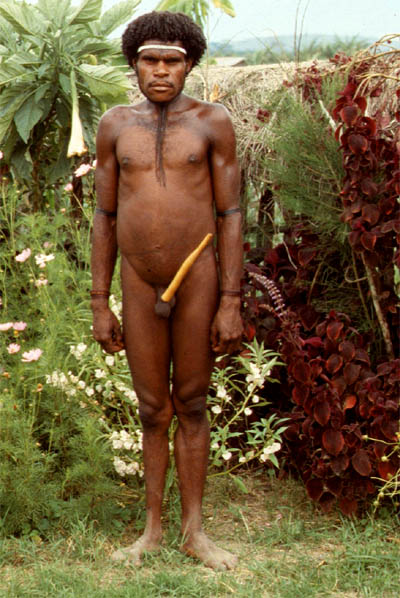
| My real first Papua man. The receptionist?
|
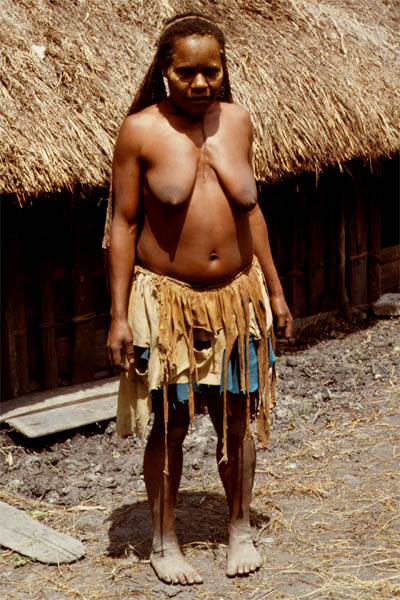
| My real first Papua woman. The housekeeper?
|
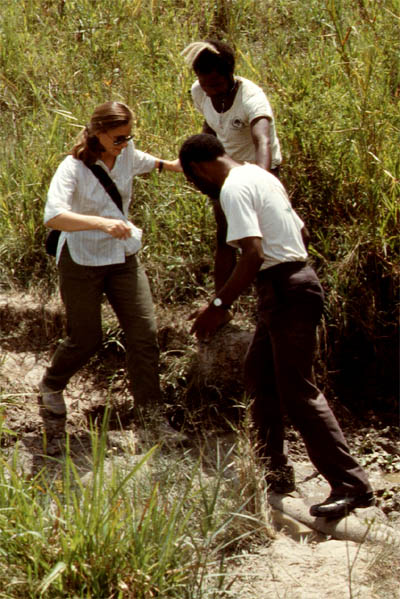
| But I still prefer a white woman
|
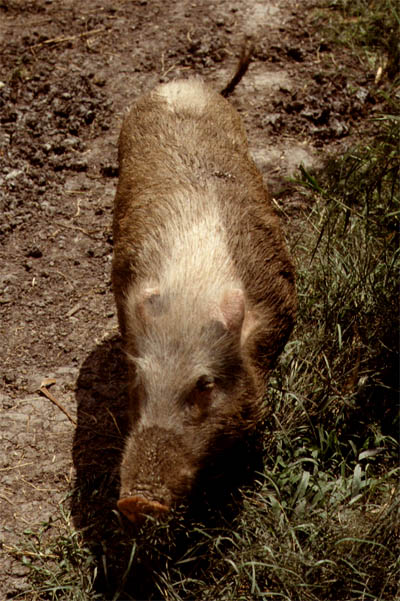
| not to eat, though, rather meat from a pig
|
Maybe it will not only be a pig slaughter festival, but also a cannibalistic event. It has happened in the Seventies that a Dutch couple was cooked and eaten in this area (as I have learned later on).
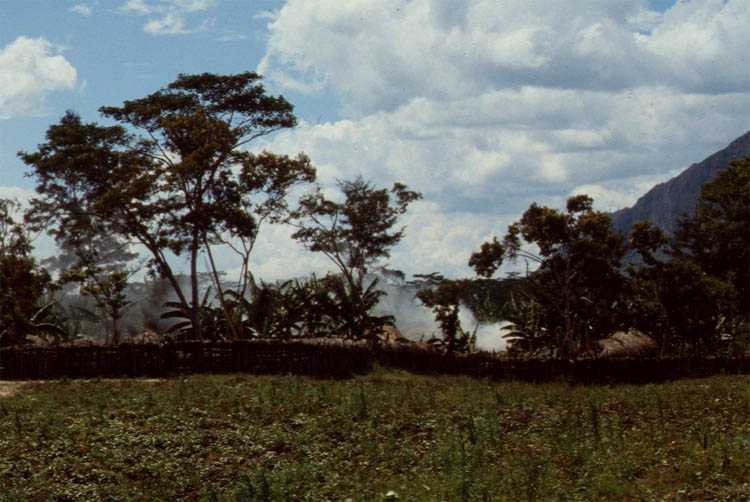
| Barbecue already smells
|
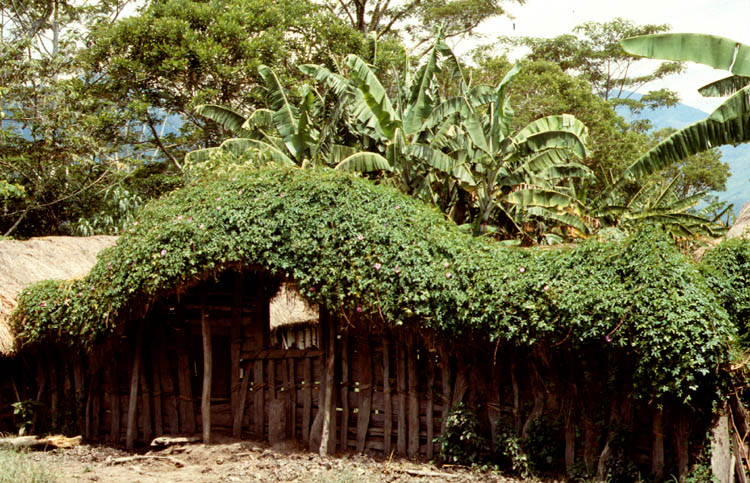
| from the village behind
|
Then we finally were propelled into the Stone Age. Earth ovens are being piled up with hot stones (heated up in the fire) alternately with sweet potato leaves and pork chunks. All the pigs have already been killed during the early morning hour (with a spear shot right into the heart, I was told). I would have liked to see it, but we may have become killed by a sudden outbreak of the old savage instinct, too.
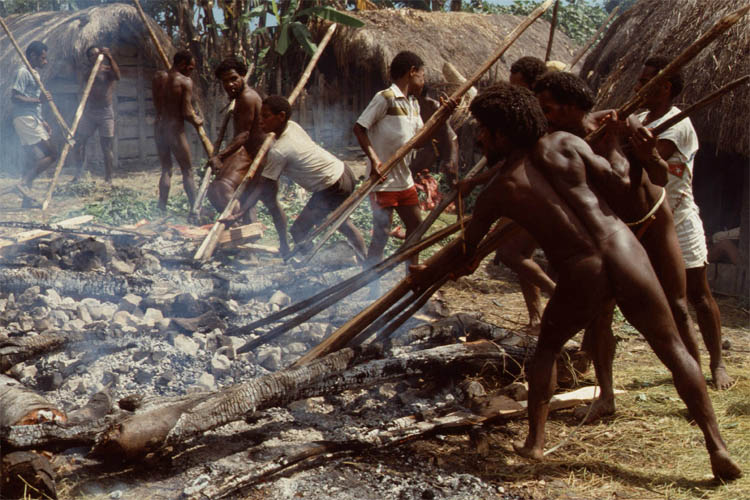
| The pig slaughter festival
|
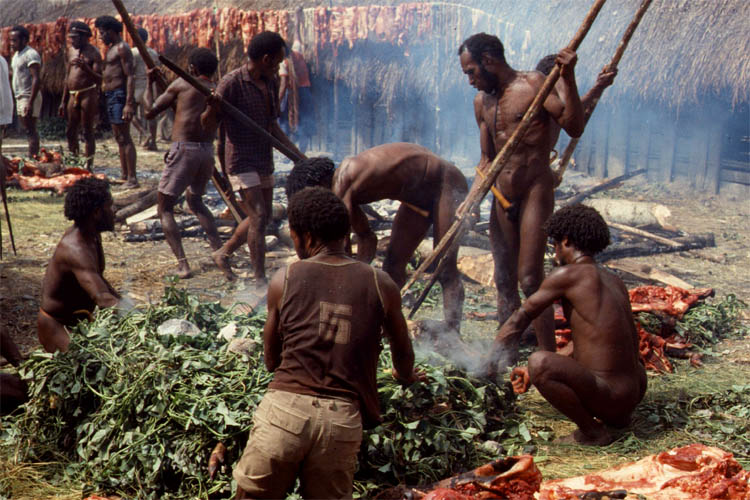
| is already in full swing
|
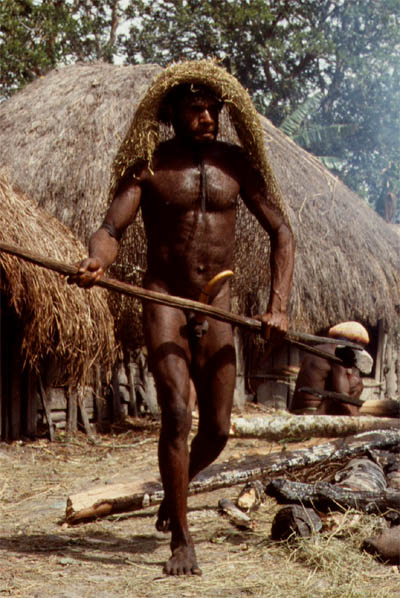
| Men either are tending the earth oven
|
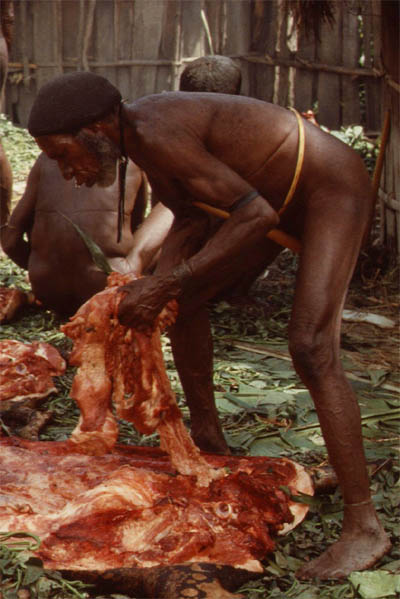
| or have been assigned the meat selection task
|
It must have been quite a number of pigs slaughtered. I was told that this event happens only twice a year. Sweet potatoes is the main staple, plus some veggies, for the rest of the year. So you can imagine that this is a real feast they indulge in. And since they cannot eat all at once, there will also some meat be dried for later consumption.
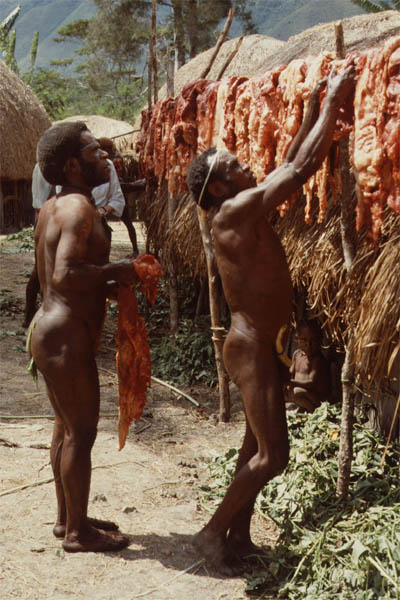
| to dry the meat
|
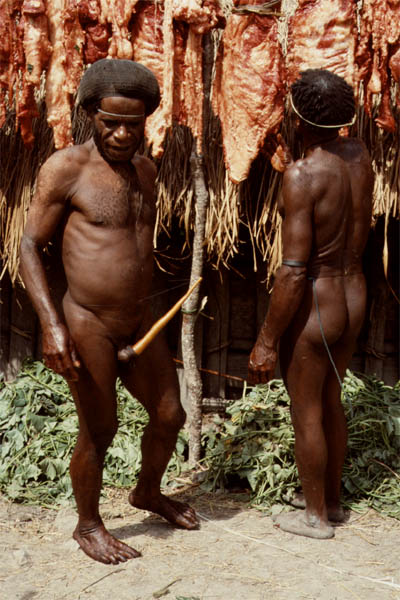
| for later consumption
|
One earth oven seemed to be ready to be "unearthed". Men are gathering at one end of the village close to their men huts forming a circle with the cooked meat in the middle. The women do likewise at their end in front of the women's quarters, but without meat.
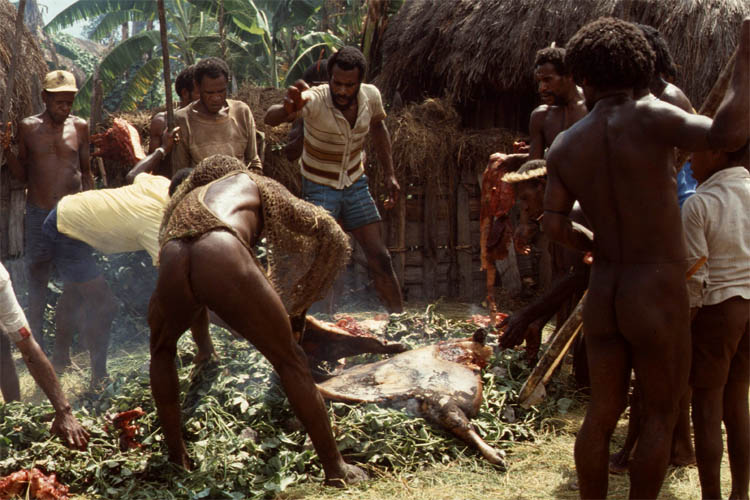
| The meat is ready for the feast
|
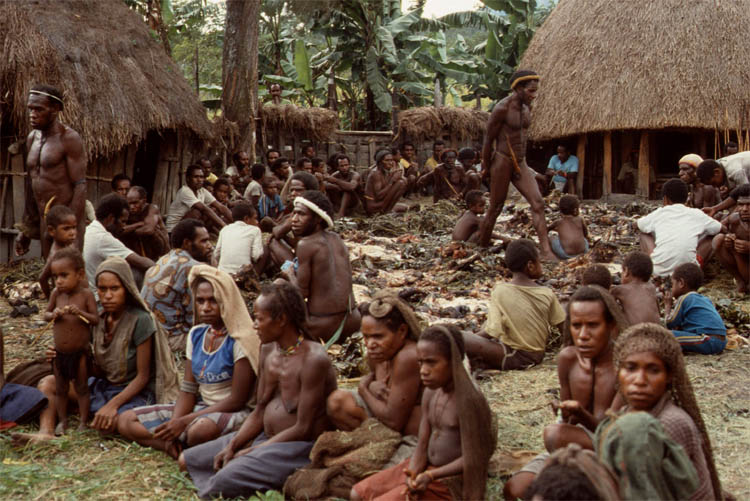
| but not for the women yet
|
After shaking hands with the chief (or elderly) and with some of his "adjutants" and presenting our cigarettes, we were officially invited to join the feast. And it was delicious, but only the meager tender meat. Most of it was fat but even more liked by the Papuas.

| We were also invited to join the feast
|
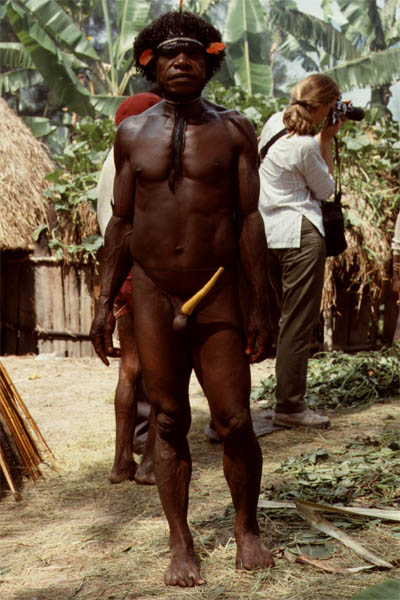
| A white woman was an exception
|
Q&A: What are the Papua women for? To get children, of course. How can they get children if they are not sleeping together with their men? They make love in the bushes. Can she keep all her children until grown up? No, the boys will move to the men's house when they become six years old.
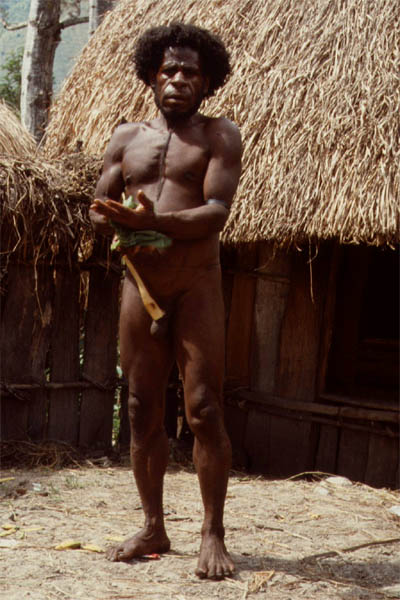
| Men are proud to be special
|
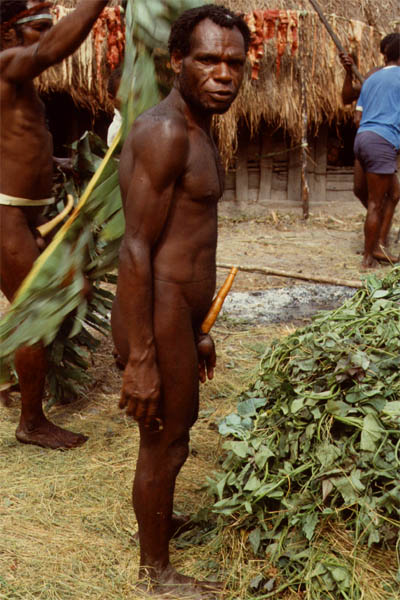
| and thus usually come first
|

| The men really have the guts
|
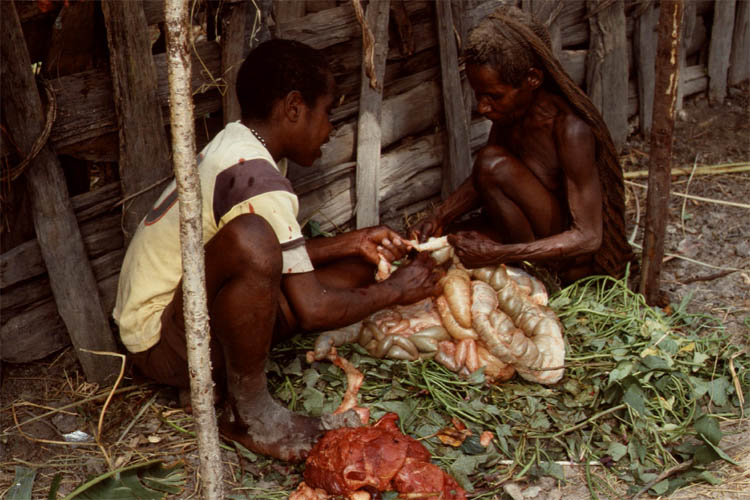
| to leave the guts for women
|
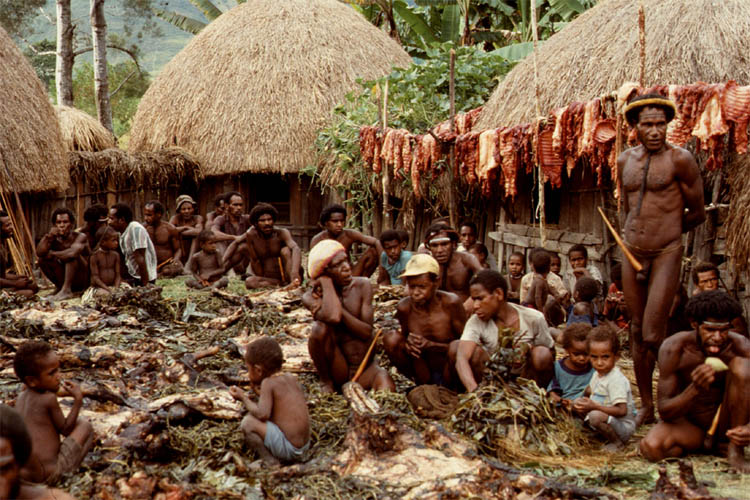
| While the kids may now join
|
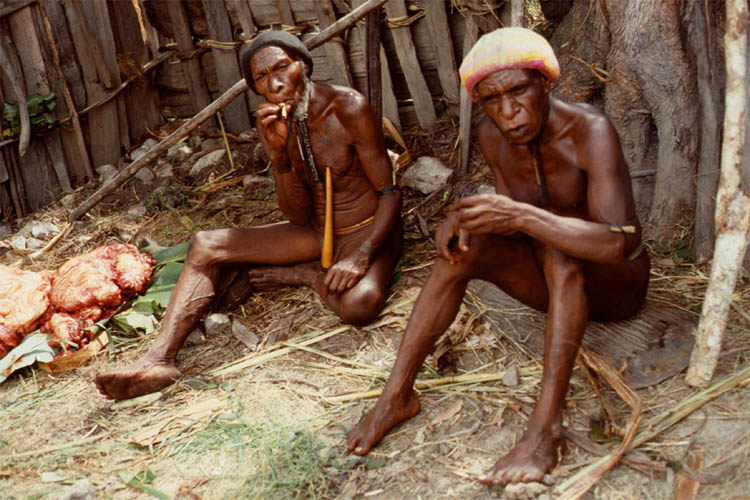
| the men are having their joints
|
Second day in the Baliem Valley
Next morning after an almost sleepless night on the hard floor in the cold hut we trekked up the hill to warm up (with Justinus' brother as a guide - and a guard). We visited a salt water well (where the Papuas "produce" their salt) and then we had a nice view over the Baliem Valley. In the afternoon we checked out and were charged around 10 USD each. It was not worth the hut but still ok with the "extras". Then Justinus and I accompanied Kate back to the airport to wave her a final goodbye.
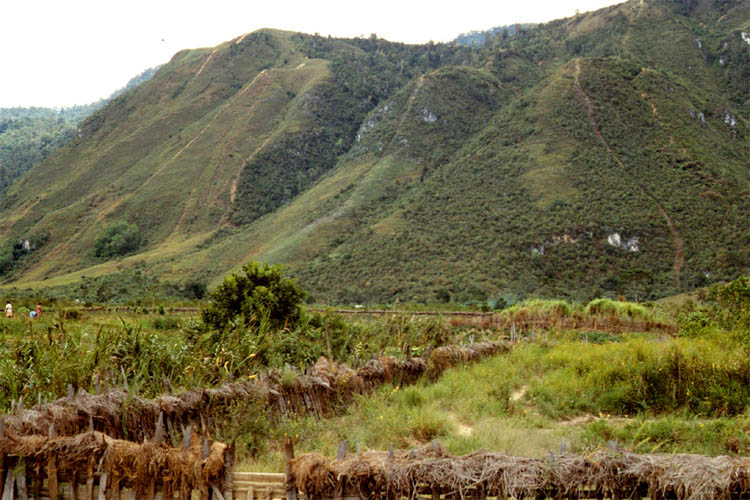
| Up the hill
|

| Up up and away
|
Then I was looking around in town where I could eat and found the Sinta Prima restaurant. The owner, Sam Chandra, offered me fresh Baliem river prawns (5 USD) and they were delicious. A regular Nasi Goreng came up to 1 USD. He also offered me to stay in his house for 10 USD a day for the room which I accepted. His address was
Sam Chandra
Jalan Trikora
Tromol Pos 41
99511 Wamena
|
He was Indonesian (from Java), had a wife and two children and a nephew who was staying with him. I even became almost like a family member. Just next day I met one of their guests, a Papua chief in his traditional outfit sitting with his naked ass on the sofa.

| Chandra family with Papua helpers
|
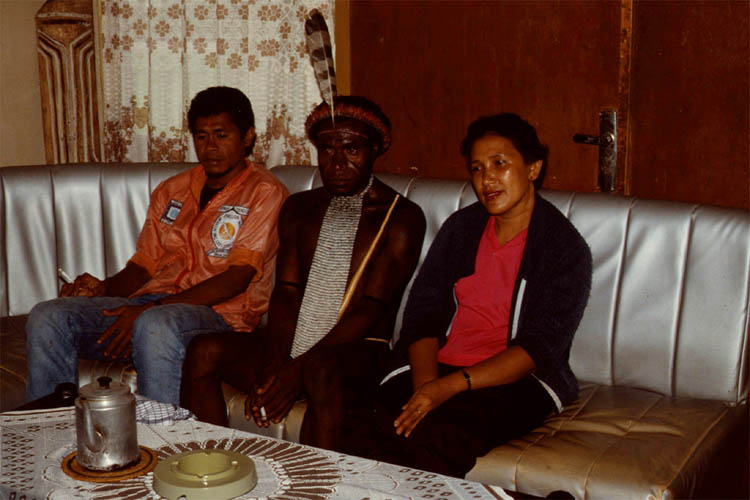
| Chandra's friend, a Papua chief
|
Third day in the Baliem Valley
The chief could only speak in his local language, but Sam's nephew (forgot his first name) was able to translate his invitation to me to visit his village, which I also accepted. So I went on another adventure joining him right away accompanied by Sam's nephew. Public transport did not exist. Walking was the only way and sometimes not easy to walk.
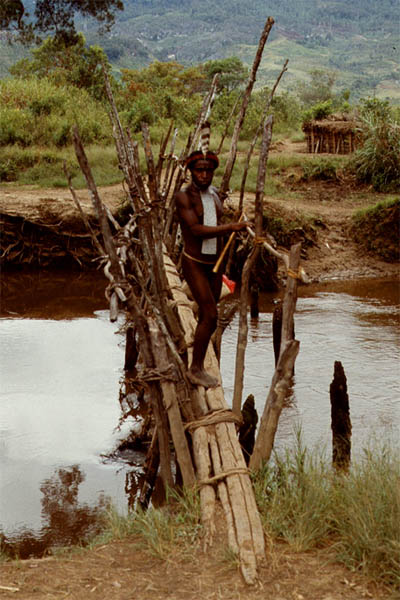
| The chief invites us for a walk
|
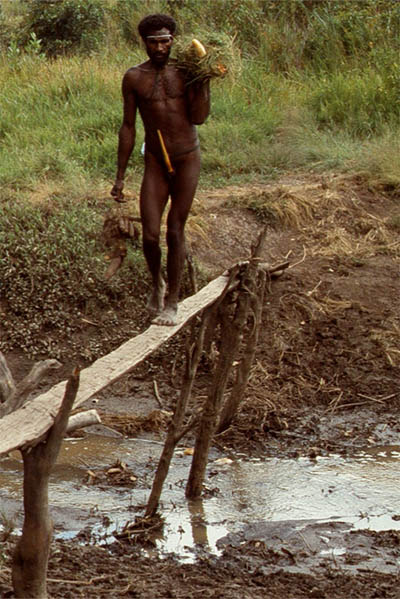
| over "troubled" water bridges
|
The reason why our chief came to town was buying new batteries for his portable cassette recorder (the only thing he carried with him all the time). Not to listen to the last hits but for recording his own tribal singalongs. The walk was very leisurely, stopping here and there, having a chat with everybody coming our way, having a drink from the creek.
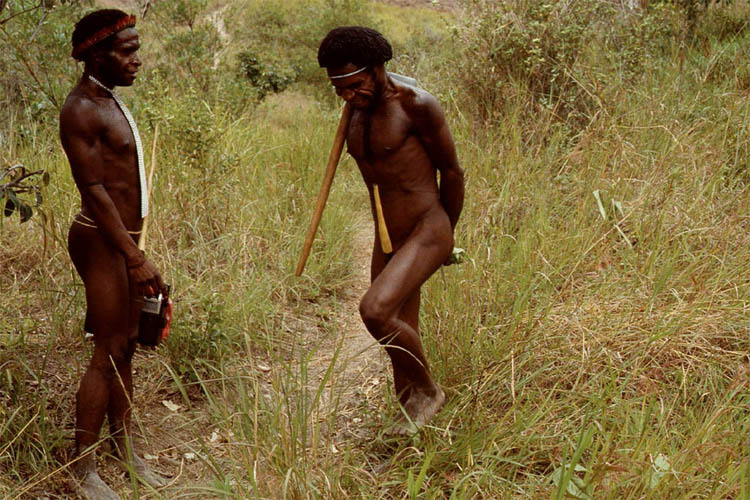
| Talking about last gossip?
|
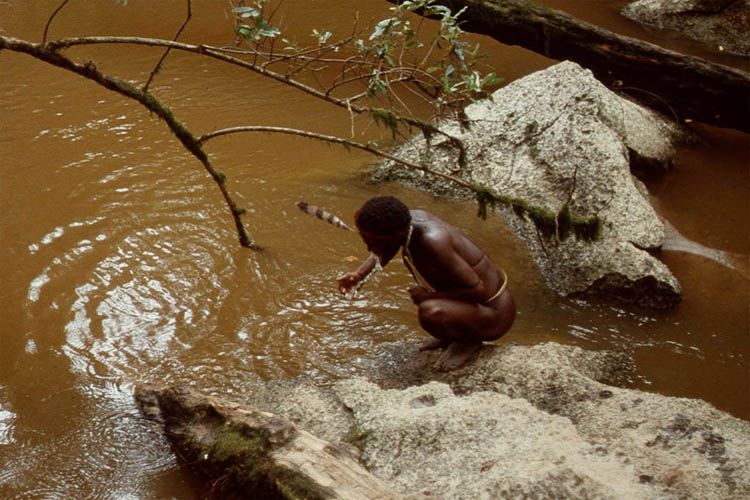
| The water seemed to be potable
|
Also talking all the time. My "interpreter' had a hard time to follow. But the following was interesting: When the chief was a boy he followed his father to ambush some warriors of another clan from the next village (yeah, almost each village around fought against each other in the old times). Some enemies were killed on the spot, some wounded trying to escape but chased to eventually suffer the same fate.

| Telling us about an ambush here
|

| One enemy was killed right there
|
The government stopped the man hunt (and man eating). So the Papuas had to stick to the vegetarian diet (not counting pork twice a year), mainly (80 %) of sweet potatoes, especially in the Baliem Valley (a healthy diet: no Papua gets a heart attack). The fields are a sacred place and certain fertility rites (some even bloody) are performed during the planting season. Only men are allowed to tend the crops. Women (responsible for other veggies) and strangers (so was I) are not allowed to even step on one of the sacred fenced-in soil.
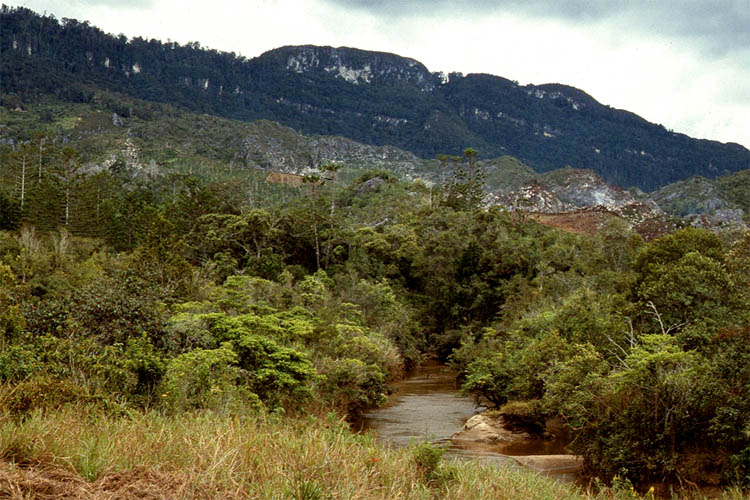
| No enemies are killed and eaten around here anymore
|
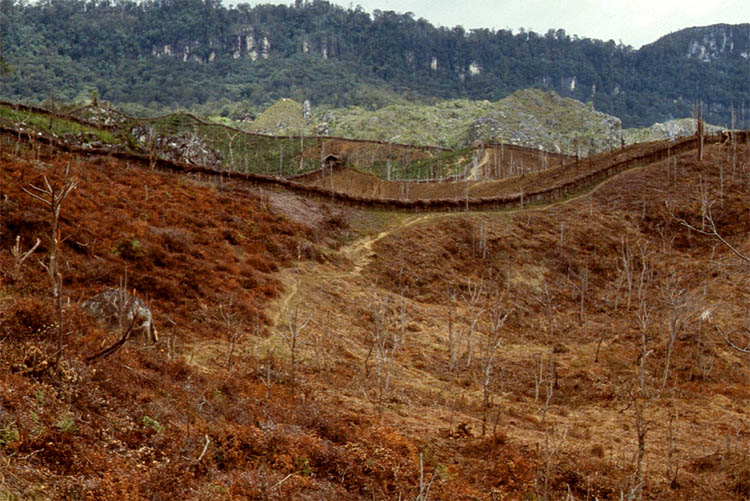
| Harvesting and eating sweet potatoes is less dangerous
|
Fourth day in the Baliem Valley
Another trekking tour (together with Sam's nephew again) to the village Akima which houses a famous smoked mummy. One old chief who died about 200 years ago and who has been preserved by having him smoked to the bones. The village people really exploit this unique mummy by charging 10 USD just to take a look at old smoky.
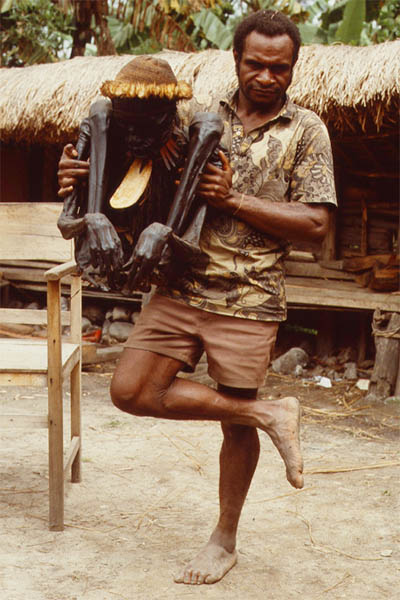
| In the village of Akima
|
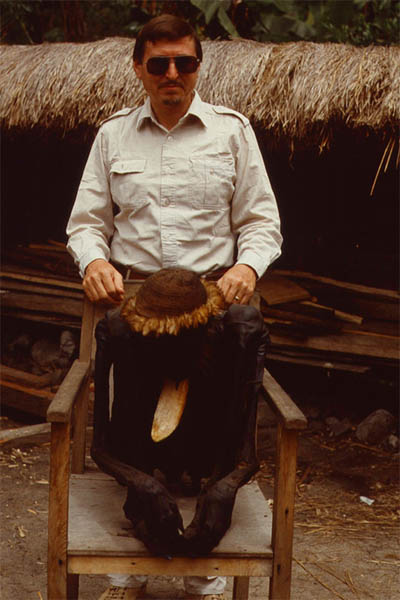
| with the famous mummy
|
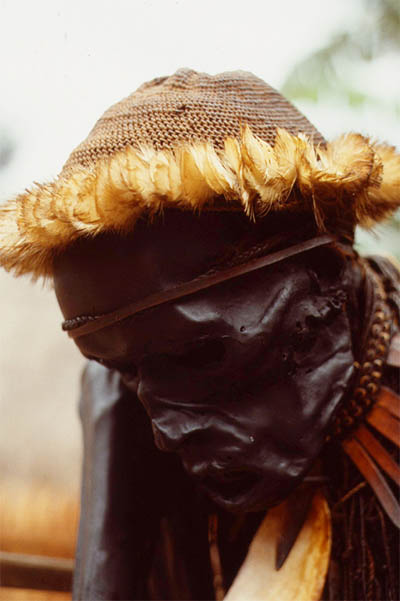
| Very well smoked head
|
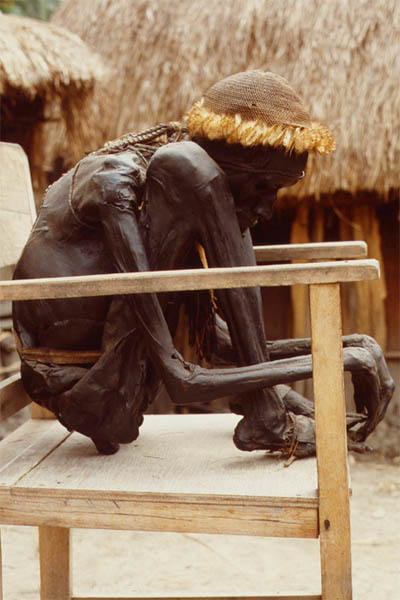
| and the whole body as well
|
I did not entertain that mummy village in return but saved my balloons for the kids of the next village (all the villages in the Baliem Valley are only a few kilometers apart). During the day, they were almost deserted. Most work to be done is outside in the fields to keep up with the food supplies. Not much to do in the village itself, except for feeding the pigs and doing some knitting, etc.
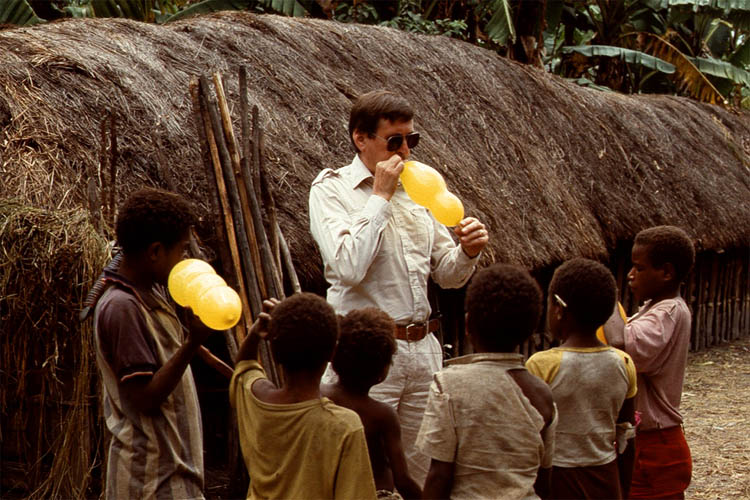
| Not much else around except the kids
|
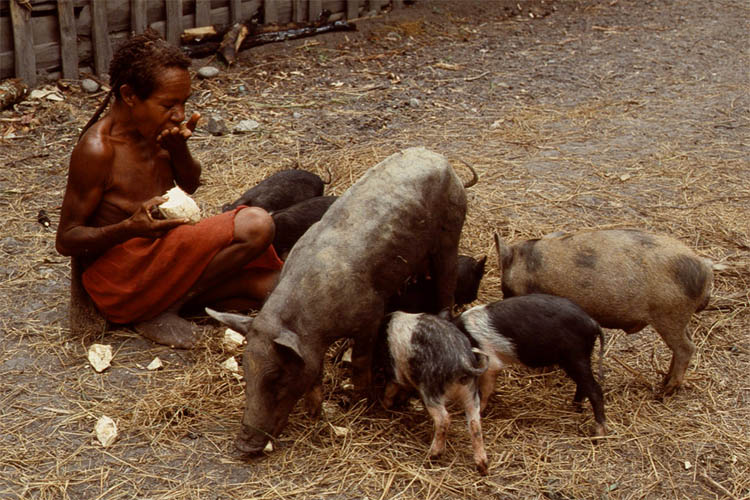
| and a woman feeding her pigs
|
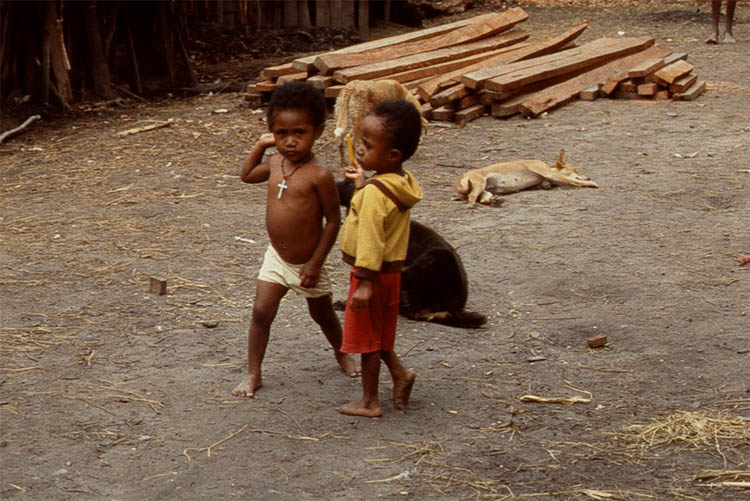
| Kids are playing around the dogs
|
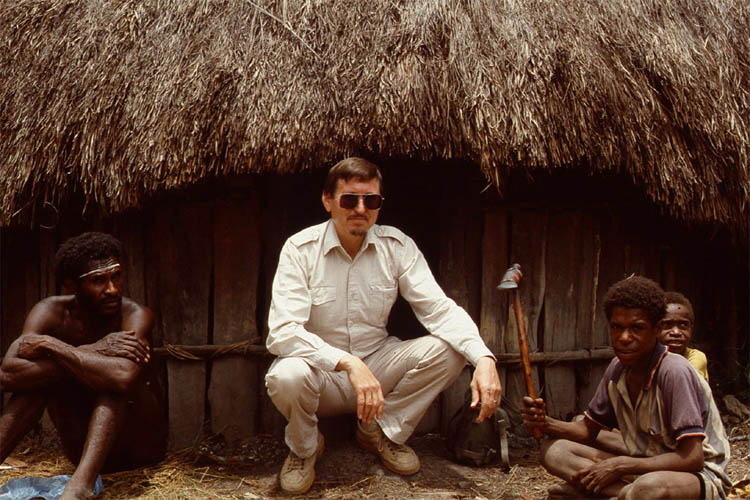
| A boy is showing me a stone ax
|
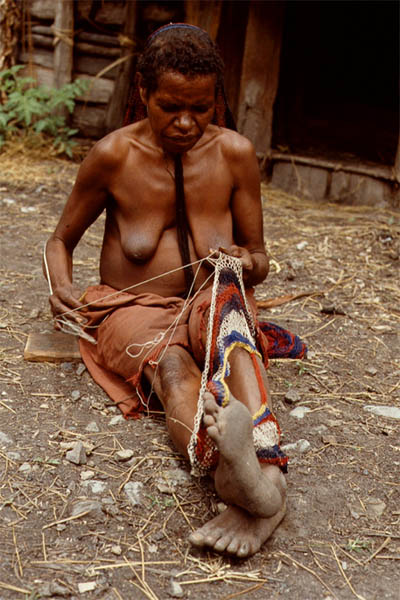
| Another woman is busy knitting a net
|
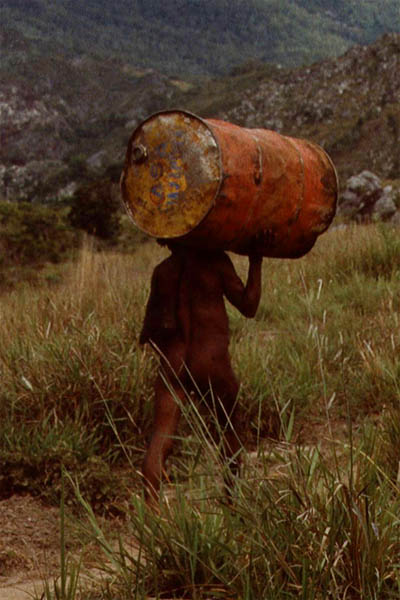
| A man with an oil drum on our way back
|
Fifth day in the Baliem Valley
In order to reach more villages down the valley we rented a motorbike next day for the whole day for 10 USD. Sam's nephew did the driving. This really was some kind of a motocross tour. No road, not even for off-roaders (partially too narrow the trail). And we were lucky that we didn't get a flat tire or even an engine breakdown. We drove all the way to Pyramid (a hill shaped like one) and the bridge to Pilimo. On the way back we even were really hit hard by torrential rain (though I had my rain coat). But first we had our first encounter with a Papua gathering.
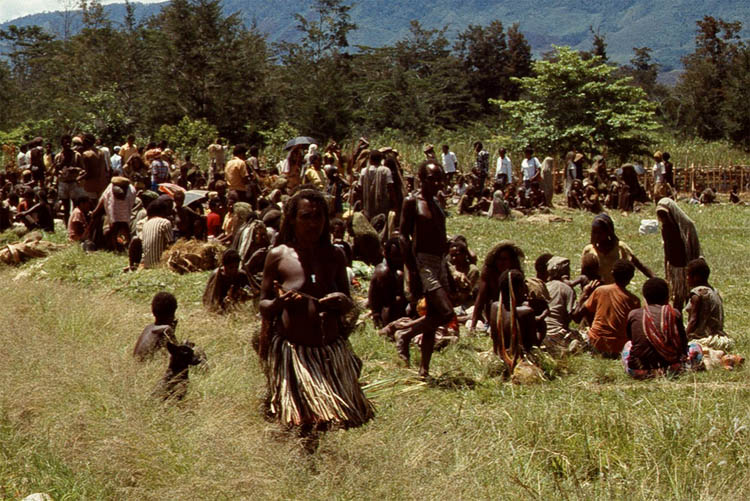
| Then another encounter: A market or
|

| some kind of a get-together
|
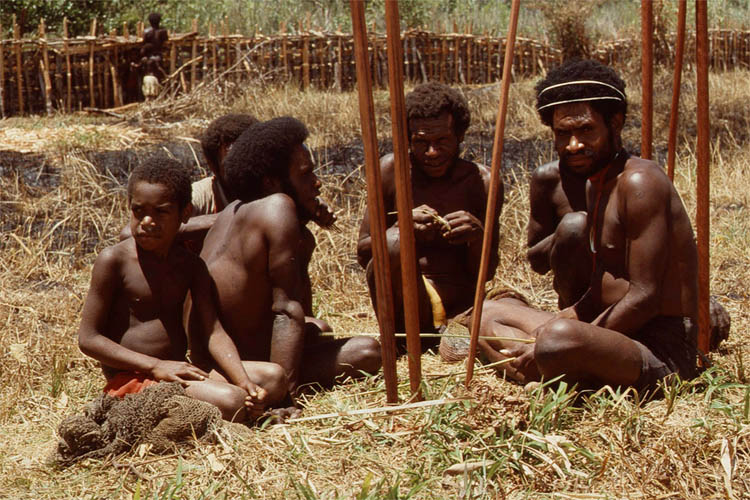
| Guarded by strong men
|
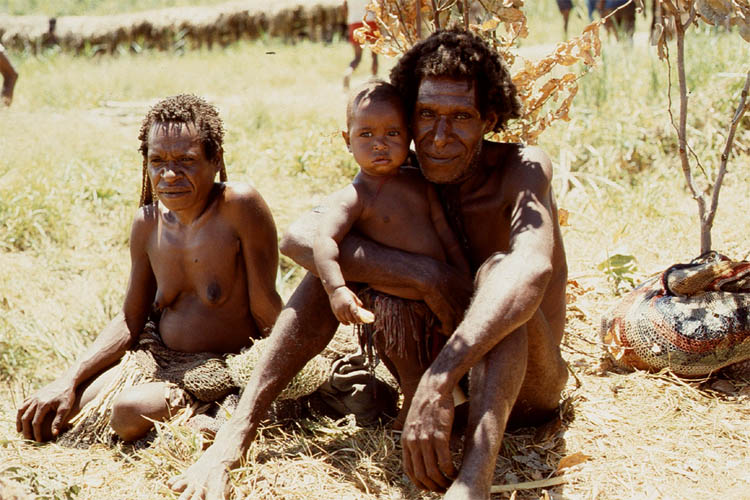
| and attended by families
|
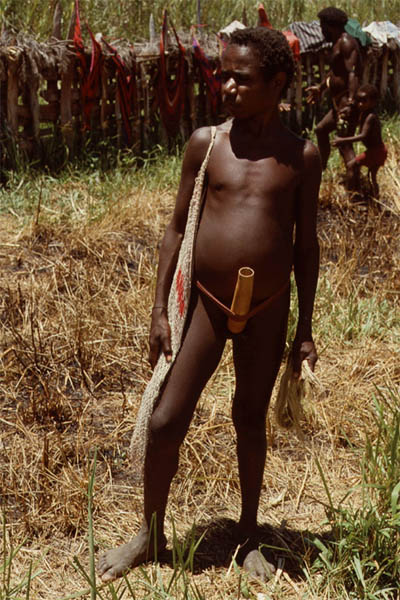
| And boys
|
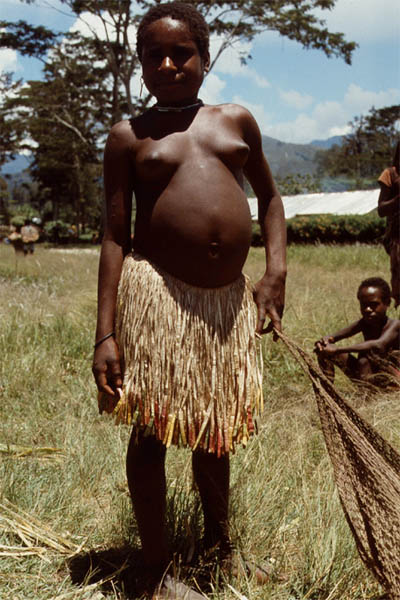
| meet girls?
|
Next came a checkpoint, where I had to present my permit and had to write down my name in a register book (I went through the same procedure several times before). So, if I should get lost the better I can be traced to the pot, I was cooked, so that the chief to the jail could be put. After just passing the border, we met another tribe, the Lani, having another pride: a penis gourd pretty wide. I asked the guy to have a look inside and I saw it full of tabacco and a pipe.
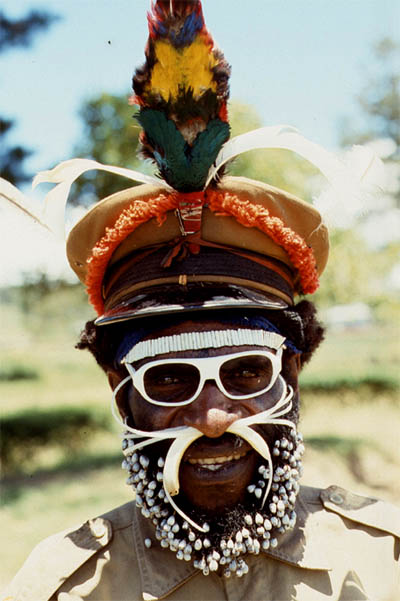
| This is Checkpoint Charly
|
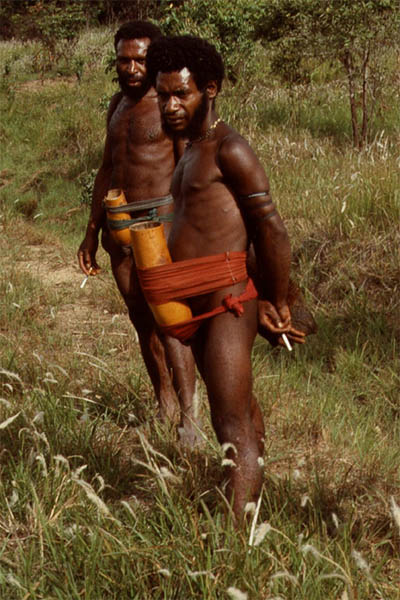
| They are flaunting, the Lani
|
Then finally we reached the American mission, but the missionary wasn't home. Maybe he was flown out (he had his own airstrip).
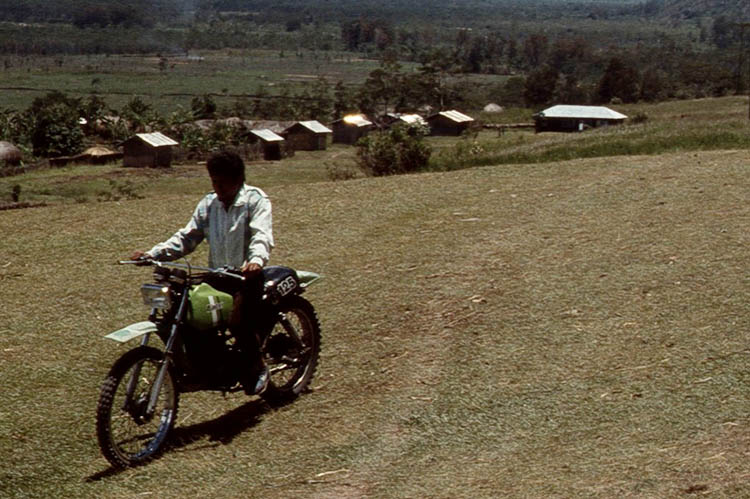
| After a long streneous ride
|
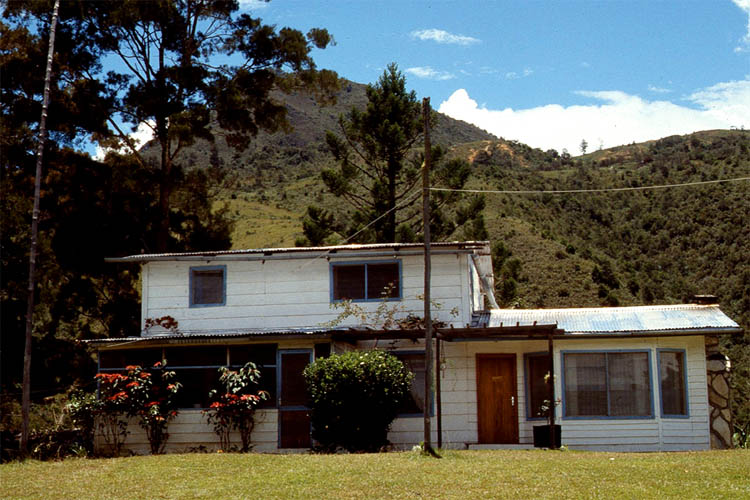
| we reach the mission-ary's hide
|
So we strolled around and watched the men and children having a good time. From here we did not drive any further but slowly turned around for the long ride back home.
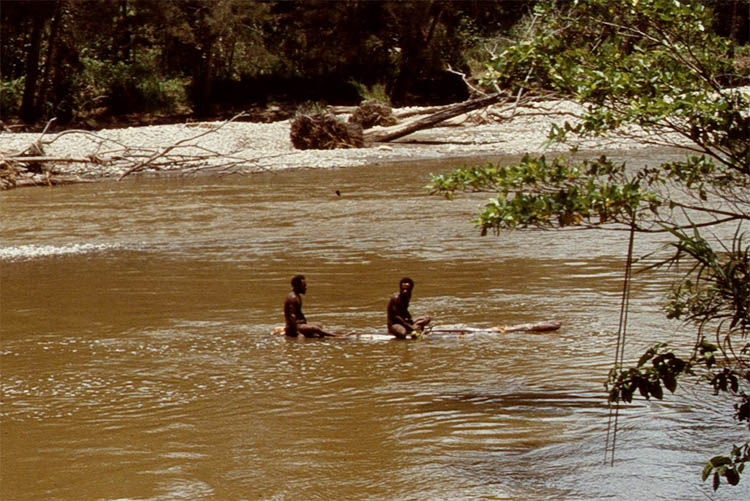
| Some parts of the river
|
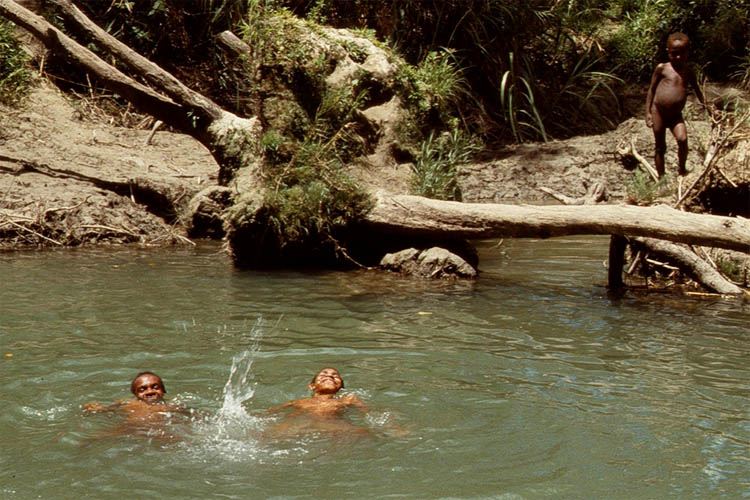
| inviting for a swim
|

| It's a paradise for the children
|
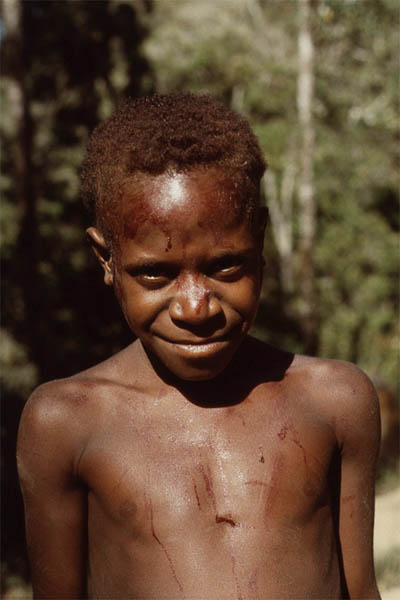
| and this bloody kid is smiling
|
Sixth day in the Baliem Valley
Today is Sunday, so going to church for the mass was mandatory. The church was full and the Dutch priest held a sermon in the local language. After the sermon I had my favorite meal for lunch.

| After the church mass
|
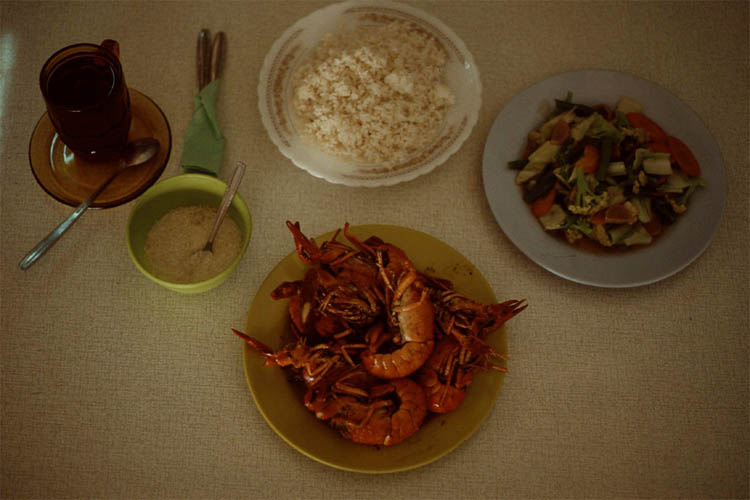
| Having a good lunch
|
Then on Sunday afternoon I finally found the time to head off to the market place in the middle of Wamena town. It was so interesting to stroll and look around alone. From too much talking I will refrain, the photos will better itself explain.
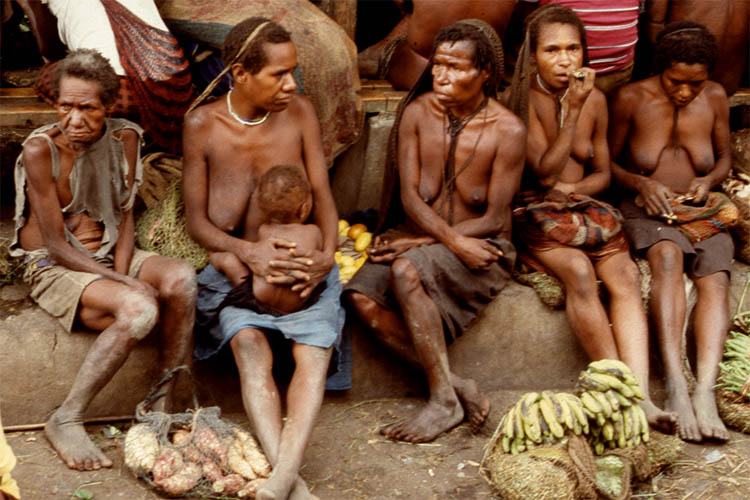
| Market day: Women selling bananas, etc.
|
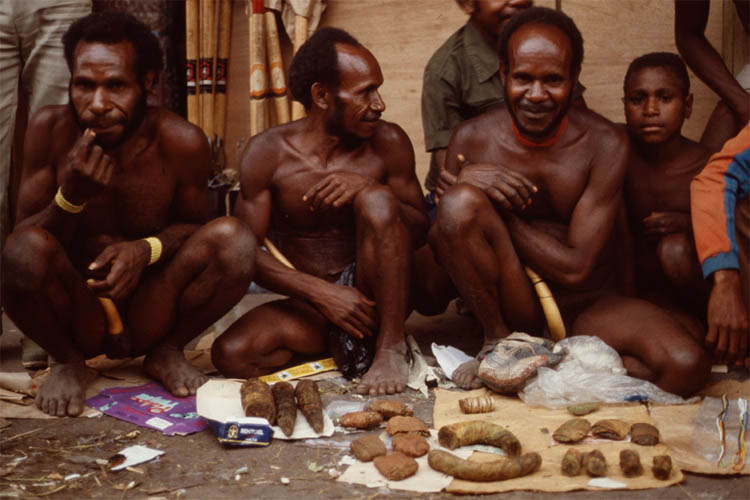
| Men are selling aphro-disiacs?
|
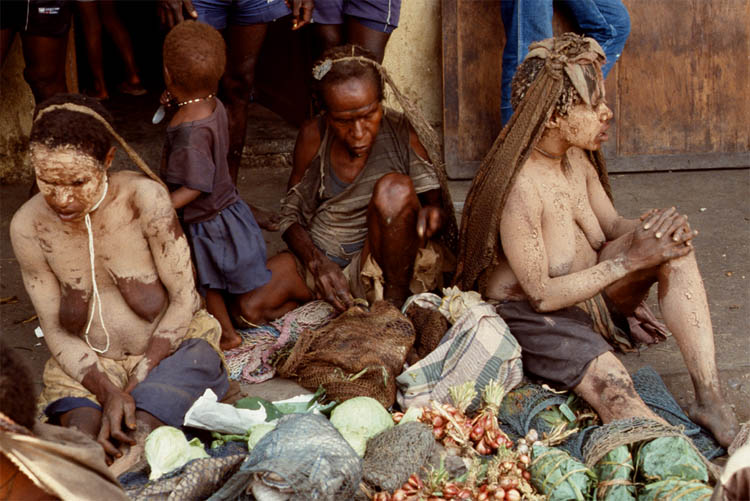
| To be a white woman is very sexy here
|
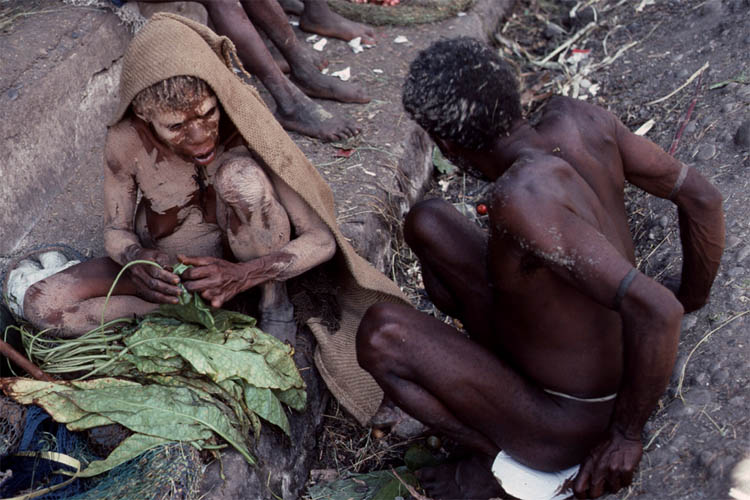
| The men never use make-up every-where
|
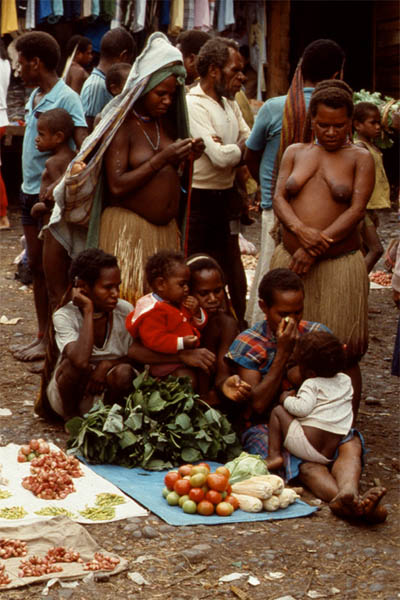
| The market offers all kinds of produce
|
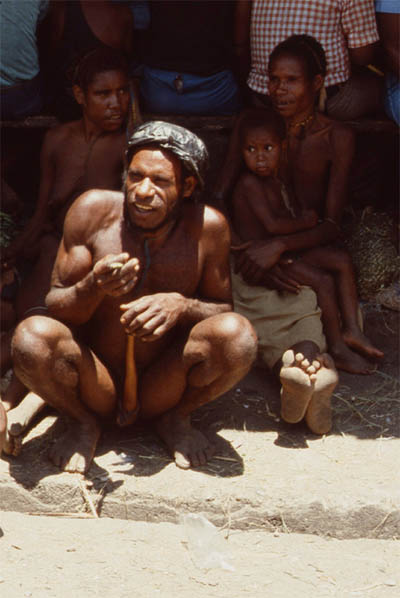
| also it's for exchanging gossips and news
|
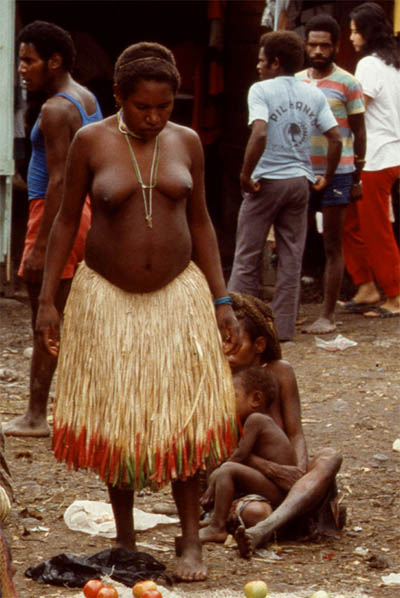
| Many young girls
|
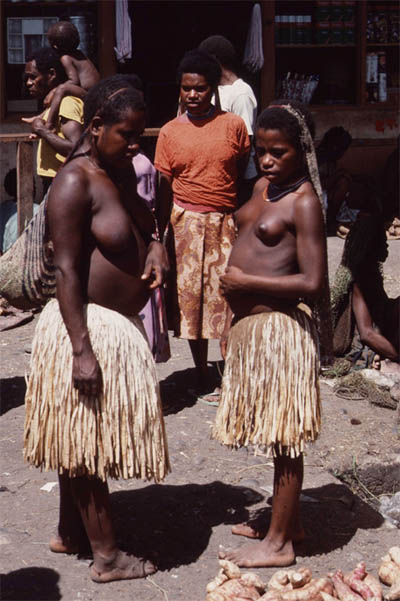
| looking for a bargain
|
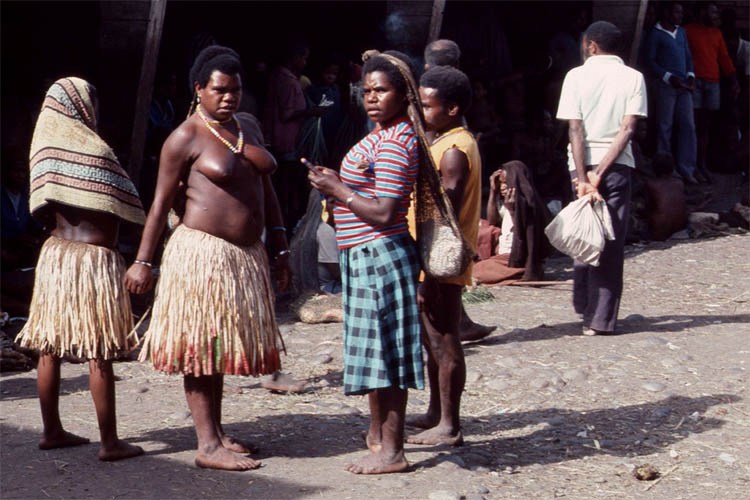
| But it's also a place just to look around
|
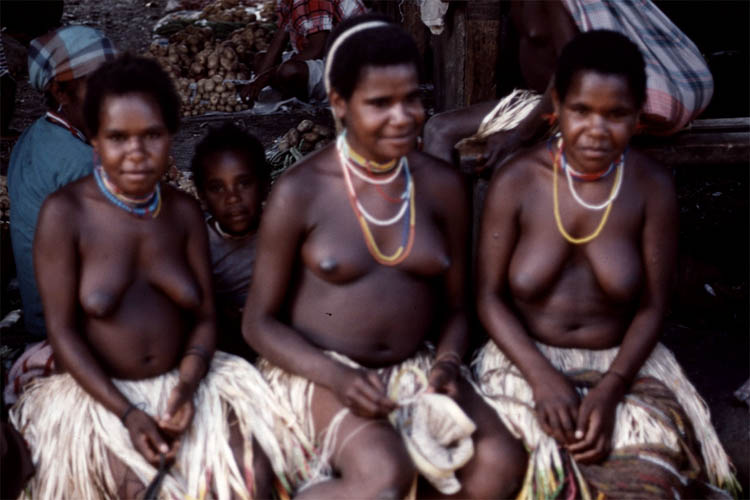
| and to be seen by a potential husband
|
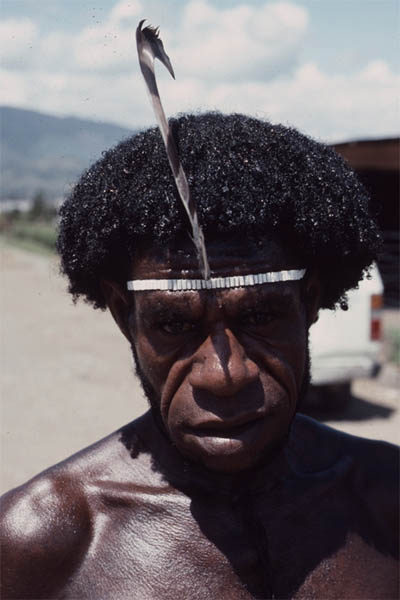
| There seemed to be a lot
|
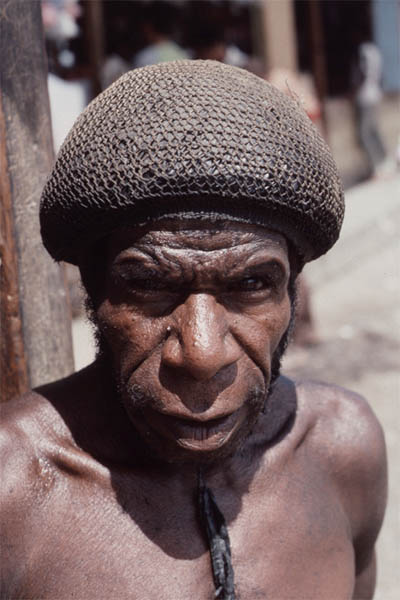
| of single men
|
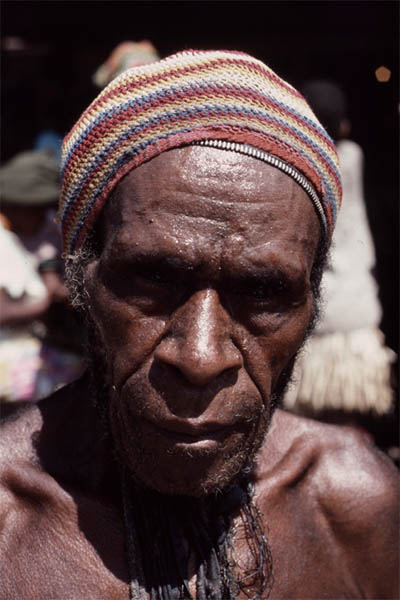
| just walking around alone
|
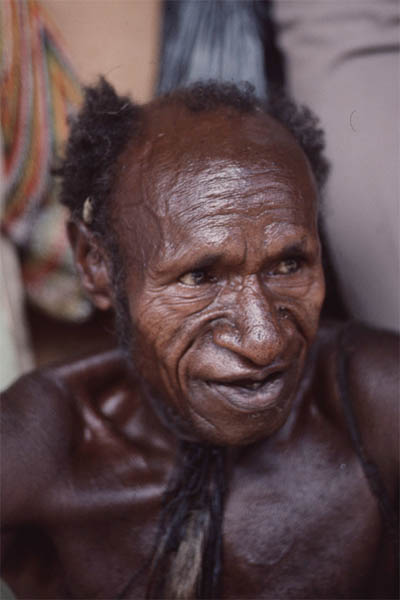
| But who wants an old bone?
|
Seventh day in the Baliem Valley
Also the last day I wanted to be on my own. Leisurely walking around the vicinity of the town. There is not so much to explain either. There is only to mention some coffee plantations around. Pepper bushes also grow here abound.
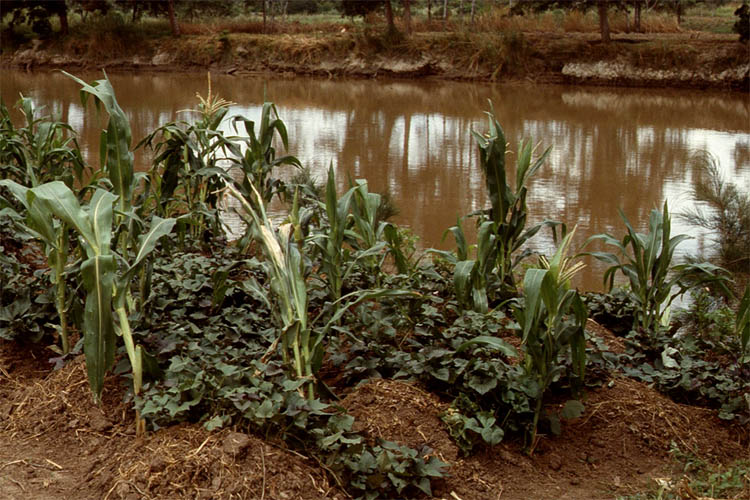
| The Baliem river
|
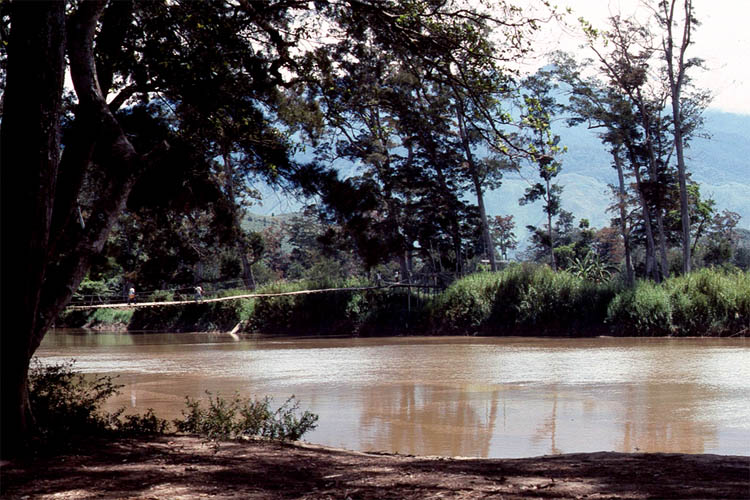
| with a hanging bridge
|
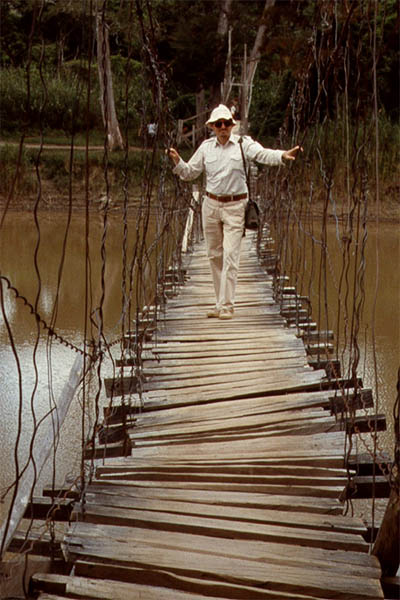
| Little bit shaky but not dangerous
|
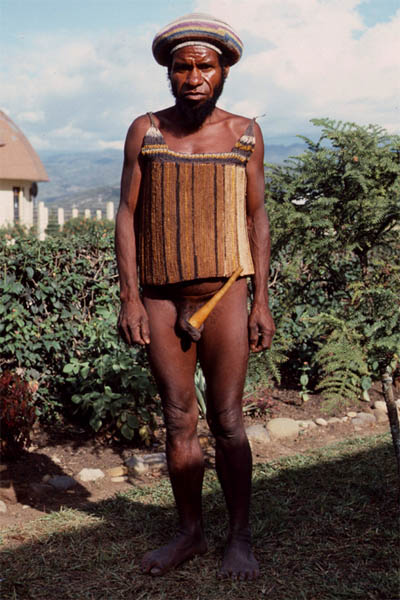
| maybe more so this armored warrior?
|
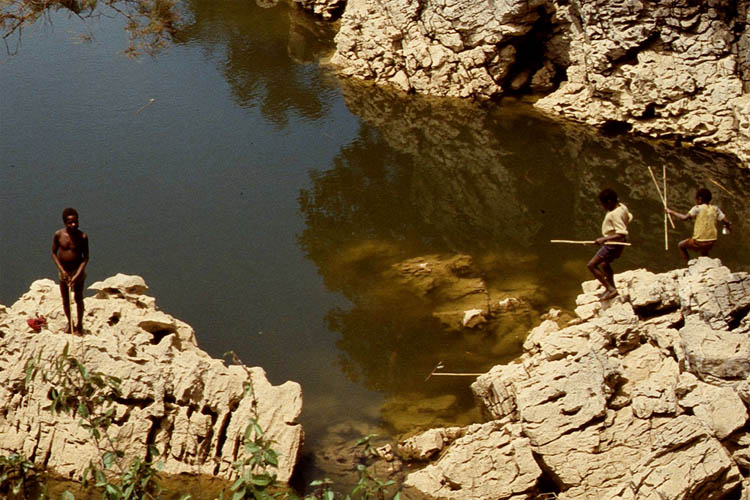
| A small pond for fishing
|
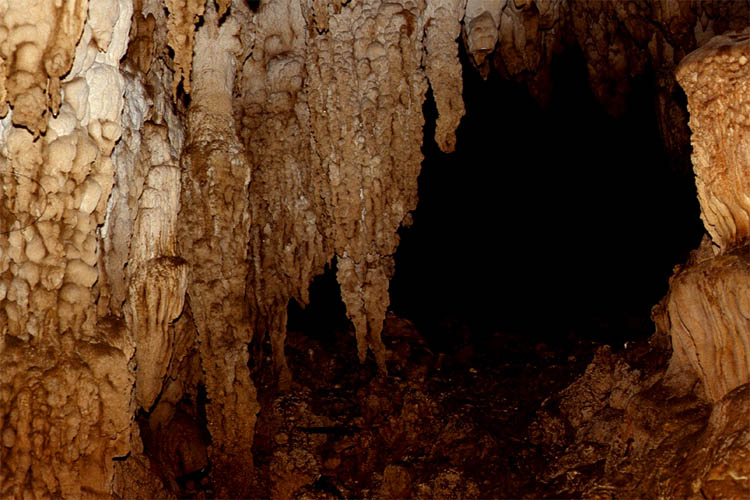
| and a cave to explore
|
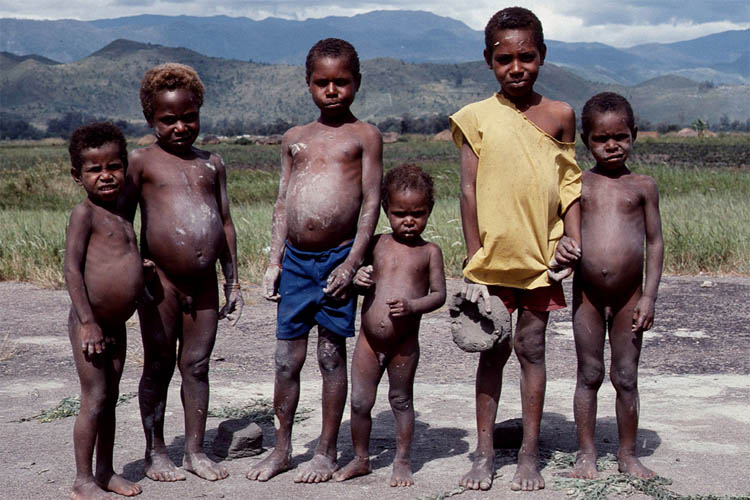
| Children are waiting at the airstrip
|

| for the next plane to go up and away
|
Eighth day in the Baliem Valley
Finally I flew back to Jayapura on the eighth day. I could have stayed longer to visit the Yale and Asmat tribes south of the Baliem Valley or climbing the Trikora Peak, as Sam has suggested but this would have meant another week and a real strenuous trek through the wilderness.
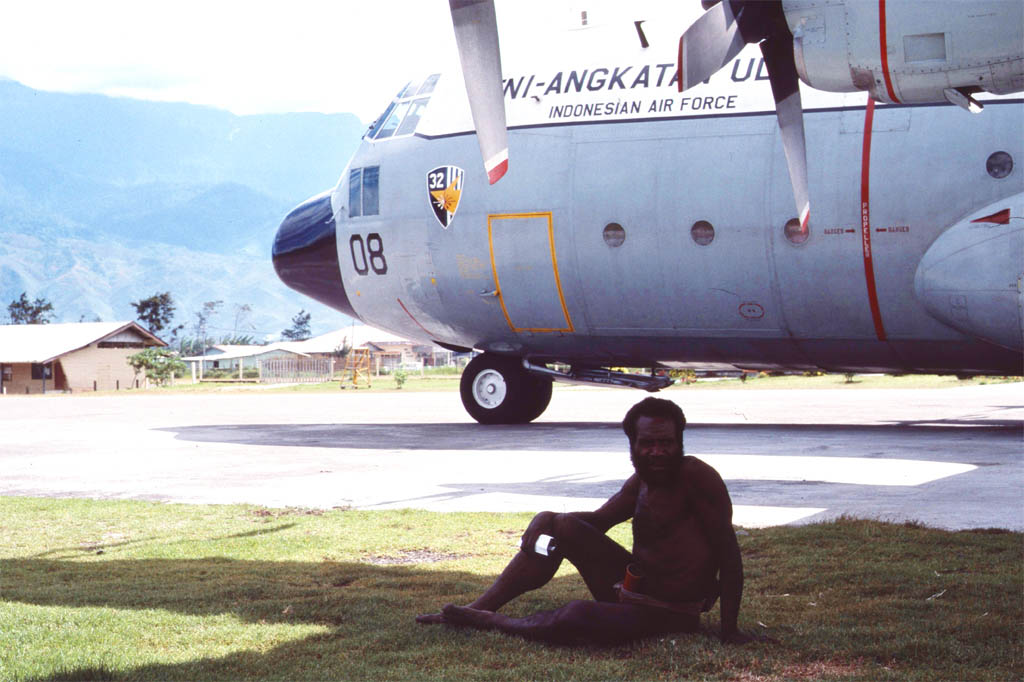
| Stone Age meets Aviation Age
|
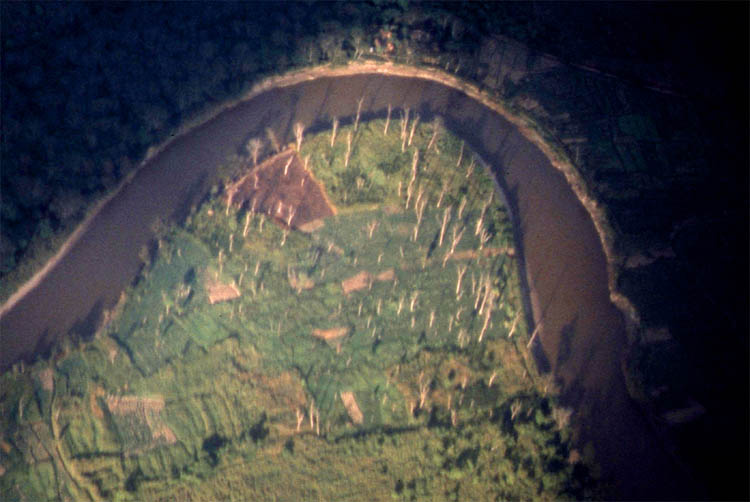
| Any undetected tribe down there?
|
Papua Epilogue
There are much more to tell about the Danis (and the Lanis) in the Baliem Valley. I have read terrible things about their old customs and their past (no "Noble Savages" as some naïve people want us to believe). And that was not so long ago. The first contact with them was somehow in the year 1938 but no other incident followed until after WW II, when the first missionary came to convert them to Christianity with limited success, at first. The old customs and believes are hard to wipe out. To forbid the wearing of the penis gourd even caused an uprising and was not pursued anymore.
But times are changing. Many little boys, as you could have seen on the photos, do not run around naked anymore but wear shorts and t-shirts, thus the next grown up generation, and that is already today, will join the jeans and t-shirt fashion world (no room for the penis gourd in a tight jeans). And not just that. I did not dare to search the internet to find out (yet). I am also afraid that more and more - especially package tours - tourists will spoil the Papuas.
As far as the political situation is concerned, there has been more autonomy granted to the Papuas now (since 2002). One even was changing the Indonesian name Irian Jaya back to Papua. And it was time, though the Free Papua Movement still wants an independent state, like Papua New Guinea.
Papua was part of Netherland East Indies until Indonesia became independent after WW II. But Indonesia, who had suffered under the Dutch rule, acted like their former oppressor and took over Papua (like: all what belonged to the Netherlands belongs to us now).
There was a first and only small majority vote of Papua chiefs to become part of Indonesia, though, but many critics state that they have been bribed.
Ok, that was Papua, though still only a small part of it.
There could have been seen and done a lot more. Also I could have written more. If you want to know more all about the places I have visited, then just look up any of the many guidebooks or in the internet.
If you want to skip now to the other parts, then just hit
Part II - Ambon/Sulawesi or
Part III - Kalimantan or
Part IV - Sumatra.
If you want to see a slide show of all previous photos then hit
Slide Show.
If you want to stop the show during the load, because it is too slow and may take too long or you are stuck, then just call up the Window Task Manager and cancel the task in question.
| 



























































































